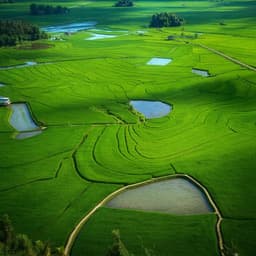
Agriculture
Optimized split nitrogen fertilizer increase photosynthesis, grain yield, nitrogen use efficiency and water use efficiency under water-saving irrigation
Z. Zhang, Y. Zhang, et al.
This groundbreaking study by Zhen Zhang, Yongli Zhang, Yu Shi, and Zhenwen Yu delves into optimizing nitrogen ratios for winter wheat, revealing that a balanced 5:5 basal-top-dressing significantly boosts grain yield and efficiency under both water-saving and sufficient irrigation regimes. Discover how this research paves the way for sustainable farming practices!
~3 min • Beginner • English
Introduction
The North China Plain (NCP) is a major wheat-producing region that contributes a large share of China’s wheat but receives only 100–180 mm precipitation during the wheat growing season, leading to reliance on groundwater irrigation and a declining water table. A water-saving cultivation technique based on supplemental irrigation triggered by soil moisture has been developed to reduce irrigation while sustaining yield and water use efficiency. Nitrogen (N) is the most demanded macronutrient in wheat; appropriate N enhances photosynthesis and grain filling, whereas excessive N increases losses and reduces nitrogen use efficiency (NUE) and potentially yield. Prior work indicates that fully basal N increases volatilization and lowers utilization, while top-dressing improves NUE and yield; split applications across stages (e.g., sowing, jointing, anthesis) can optimize outcomes. Irrigation and N management interact strongly: adequate soil moisture promotes N diffusion and root uptake, and N supply can in turn affect water productivity. However, there is limited information on optimizing the basal-to-top-dress split of a fixed total N rate under water-saving supplemental irrigation based on soil moisture. This study used a constant total N of 240 kg ha−1 split between sowing and jointing in different ratios (10:0, 7:3, 5:5, 3:7) under two irrigation regimes (water-saving SI and sufficient UI) over two years to evaluate effects on flag leaf photosynthetic performance after anthesis, grain-filling, grain yield, NUE, and water use efficiency (WUE) in the NCP. The objective was to identify the optimal split-N ratio under supplemental irrigation and clarify associated physiological mechanisms.
Literature Review
Previous studies have shown: (1) exclusive basal N application increases volatilization losses and reduces NUE, while top-dressing improves yield and NUE; (2) split applications across growth stages (e.g., 4:4:2 across sowing, jointing, anthesis with ~202.5 kg ha−1 total N) achieved higher yields than two-split ratios concentrated at sowing and jointing; (3) water and N management interact to determine wheat yield and resource-use efficiencies, with soil moisture facilitating inorganic N diffusion and root contact; (4) various managements (water-saving irrigation, reduced N rates, chemical-organic combinations) have been proposed, but optimization of split-N under soil moisture–based supplemental irrigation remains insufficiently addressed. The literature also links improved leaf N status to chlorophyll activity and photosynthetic capacity, and relates grain-filling parameters (rates and duration) to grain weight and yield, highlighting the importance of synchronizing N supply with crop demand under appropriate irrigation.
Methodology
Site and years: Field experiments were conducted during 2016–2017 and 2017–2018 winter wheat seasons in Shijiawangzi Village, Xiaomeng Town, Yanzhou, Jining, Shandong, China (35°40′N, 116°41′E), a loam soil in a warm temperate continental climate on the North China Plain. Pre-experiment 0–20 cm soil: organic matter 14.20 g kg−1; total N 1.13 g kg−1; available N 122.60 mg kg−1; available K 129.44 mg kg−1; available P 38.11 mg kg−1. Previous crop: corn with straw returned.
Design: Randomized complete block with split plots, three replicates, plot size 20 m², 2 m buffer between treatments. Main plots: irrigation regimes; subplots: N split treatments. Cultivar: Jimai22. Sowing: 12 Oct 2016; 24 Oct 2017; target plant density 1.8 million ha−1. Harvest: 8 Jun 2017; 7 Jun 2018.
Irrigation regimes: Water-saving irrigation (SI): maintain relative soil water content (RSWC) to 70% at jointing and anthesis. Sufficient irrigation (UI): maintain RSWC to 90% at jointing and anthesis. Irrigation amount M (mm) computed as M = 10 × r × H × (βi − βj), where r is bulk density of quasi-moist soil depth, H is pseudo-moist soil depth, βi is design water content, and βj is pre-irrigation soil water content; applied via hose and measured by meter.
Nitrogen treatments: Constant total N 240 kg ha−1 split between sowing (basal) and jointing (top-dress) as: N1 10:0, N2 7:3, N3 5:5, N4 3:7. Fertilizers: urea (46% N), calcium superphosphate (P2O5 12%) at 150 kg ha−1, and potassium chloride (K2O 60%) at 112.5 kg ha−1. Basal N and all P and K were surface-applied and incorporated (0–20 cm) before sowing. Top-dress N at jointing was placed in furrows and covered.
Measurements:
- Photosynthetic parameters on flag leaves after anthesis: net photosynthetic rate (Pn), transpiration rate (Tr), intercellular CO2 concentration (Ci) measured with CIRAS-2 between 09:00–11:00 on sunny, windless days at 7-day intervals from anthesis to maturity (5 times per season). Instantaneous WUE (IWUE) = Pn/Tr.
- Chlorophyll fluorescence: Fv/Fm, ΦPSII, photochemical quenching (Qp), electron transport rate (ETR) measured using FMS-2 fluorometer; leaves dark-adapted 30 min; reported values averaged over five measurements during grain filling.
- Grain filling: Marked 300 stems per plot at anthesis; sampled spikes at 7-day intervals (five times); dried and weighed; 1000-grain weight determined; logistic growth model fitted to grain weight vs. time to derive Tmax (time to maximum filling rate), Vmax (maximum filling rate), Vmean (mean filling rate), and D (filling duration).
- Grain potential storage capacity (GPSC) and storage capacity index (SCI): GPSC = SPUA × NOS × GSC; SCI = 1000 × grain weight / (GSC × 1000); where SPUA is spikes per unit area, NOS is number of seeds, and GSC is single fresh grain volume by drainage.
- Plant N concentration: samples at before-winter, jointing, anthesis, and maturity; dried, milled, and analyzed by Liu method.
- Yield and efficiencies: Grain yield (GY) from 2 m² area per plot at maturity. Soil water content measured at sowing and maturity; groundwater recharge, runoff, and deep seepage assumed negligible. Evapotranspiration (ET, mm) = change in soil water content + rainfall + irrigation. WUE = GY/ET. NUE = GY/NG, with NG the grain N accumulation.
Statistics: ANOVA using GLM (SPSS 13.0) for effects of irrigation (I), nitrogen (N), year (Y), and interactions; correlation analyses among physiological and agronomic traits; logistic fitting for grain filling. Significance at α=0.05. Charts prepared with Excel and SigmaPlot 12.5.
Key Findings
- The 5:5 basal:top-dress split (N3) consistently outperformed other splits (N1 10:0, N2 7:3, N4 3:7) at a constant total N of 240 kg ha−1 under both SI and UI across two years.
- Grain yield: N3 increased GY by 16.27%, 7.09%, 5.70% (vs. N1, N2, N4) under SI in 2016 and by 16.72%, 8.88%, 5.89% in 2017; under UI by 17.75%, 10.68%, 5.27% in 2016 and 15.22%, 8.01%, 6.87% in 2017. Absolute GY means (kg ha−1): SI—N1 7293 (2016), 6907 (2017); N3 8480 (2016), 8062 (2017). UI—N1 7450 (2016), 7164 (2017); N3 8772 (2016), 8254 (2017).
- Nitrogen use efficiency (NUE, kg kg−1): N3 was highest in both years and irrigation regimes (e.g., SI: 35.33 in 2016, 33.59 in 2017; UI: 36.55 in 2016, 34.39 in 2017), significantly exceeding N1, N2, N4.
- Water use efficiency (WUE, kg mm−1 ha−1): N3 significantly improved WUE under both irrigation regimes (e.g., SI: 18.88 in 2016, 20.20 in 2017; UI: 17.19 in 2016, 18.16 in 2017). SI increased WUE relative to UI by 9.75% (2016) and 10.79% (2017). IWUE at the leaf level under SI exceeded UI by 5.34% (2016) and 6.45% (2017).
- Photosynthetic performance after anthesis: N3 significantly increased flag leaf Pn, Tr, IWUE and decreased Ci at 7, 14, 21, 28 days after anthesis under both SI and UI. Chlorophyll fluorescence parameters (Fv/Fm, ΦPSII, Qp, ETR) were significantly higher under N3 than N1, N2, N4.
- Grain filling and weight: 1000-grain weight peaked at 35 days after anthesis and was significantly higher under N3 at 21, 28, 35 days. Grain-filling parameters Vmax and Vmean were significantly increased by N3; Tmax and D were not significantly affected. 1000-grain weight positively correlated with duration of maximum filling, Vmax, and Vmean, and negatively with filling duration.
- Sink-related indices: N3 significantly increased GPSC and SCI compared with N1, N2, N4; SI further increased GPSC by ~5.8% and SCI by ~6.9–7.3% vs. UI in both years.
- Plant N concentration: No split-N effect before winter; N3 increased plant N concentration at jointing, anthesis, and maturity vs. other treatments.
- Treatment effects: Nitrogen treatment had significant effects on GY, NUE, WUE and on photosynthetic and fluorescence parameters; irrigation had significant effects on WUE and IWUE but not on GY or most photosynthetic parameters; N×I interactions were generally non-significant for photosynthetic traits but significant for WUE. Year effects were present for several variables (often higher values in 2016).
Discussion
The study addressed how to optimize the basal-to-top-dress nitrogen split under supplemental irrigation to maximize yield and resource-use efficiencies. Splitting N 5:5 synchronized N availability with crop demand during grain filling, improving flag leaf N status, photosynthetic capacity (higher Pn, IWUE), and PSII efficiency (higher Fv/Fm, ΦPSII, Qp, ETR). These enhancements supported higher grain-filling rates (Vmax, Vmean), leading to greater 1000-grain weight, GPSC, and SCI, and ultimately higher grain yield and NUE. Water-saving irrigation (SI), compared to sufficient irrigation (UI), did not depress photosynthetic parameters but increased IWUE and field-scale WUE without reducing yield, indicating improved water productivity. Excessive skew toward basal or top-dress N reduced yields, likely due to either late-season N insufficiency (too much basal) reducing photosynthesis or delayed senescence and disrupted grain filling (too much top-dress). Correlation analyses supported these mechanisms: GY and NUE were positively associated with photosynthetic and fluorescence parameters and grain-filling rates, while WUE related positively to fluorescence parameters and filling rates. Overall, the combination of SI and a 5:5 N split effectively enhanced physiological efficiency and yield formation while improving resource-use efficiencies.
Conclusion
Under a constant total N rate of 240 kg ha−1, a 5:5 basal:top-dress nitrogen split combined with water-saving supplemental irrigation increased flag leaf photosynthetic performance (higher Pn, IWUE, Fv/Fm, ΦPSII, Qp, ETR; lower Ci), promoted higher grain-filling rates (Vmean, Vmax), increased 1000-grain weight, and achieved the highest grain yield, NUE, and WUE. Water-saving irrigation improved WUE by approximately 10% relative to sufficient irrigation without sacrificing yield. This fertigation strategy is thus optimal under the tested conditions for achieving high yield with enhanced nitrogen and water use efficiencies.
Limitations
The experiments were conducted over two seasons in a single ecological region on the North China Plain using one wheat cultivar (Jimai22). Generalizability across other cultivars and environments is uncertain. Mechanistic understanding of irrigation–nitrogen interactions and validation across diverse varieties and agro-ecological zones are needed. Potential effects of varying total N rates and additional split timings (e.g., anthesis) were not explored.
Related Publications
Explore these studies to deepen your understanding of the subject.







